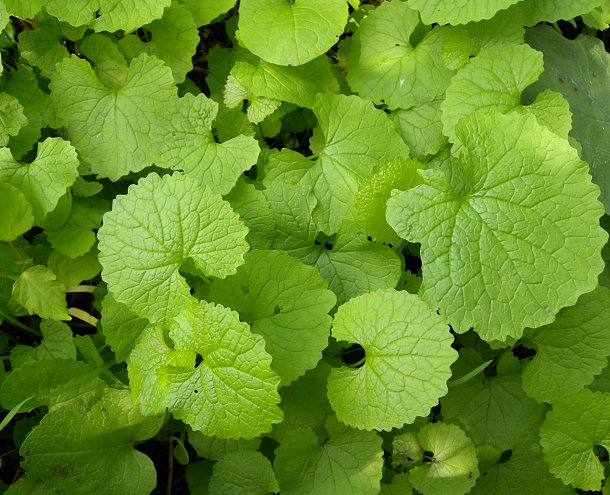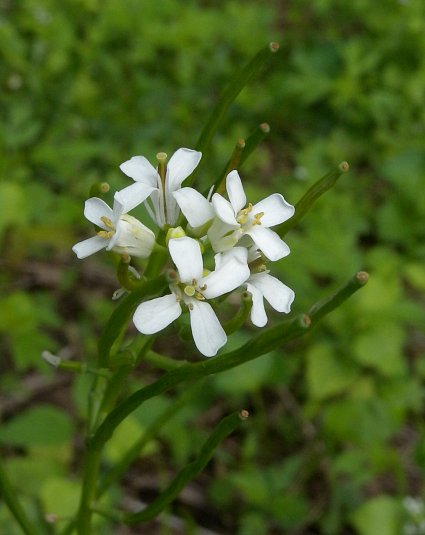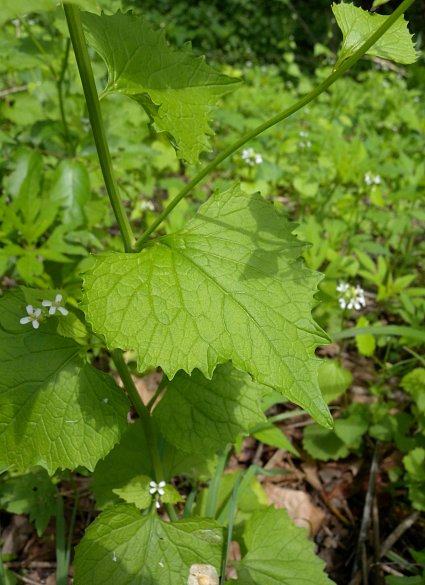Description: This plant is a biennial. During the 1st year it consists of a small rosette of leaves, while during the 2nd year it becomes a little-branched plant about 1-3' tall. The leaves of 1st year plants are up to 2" long and across. They are cordate-orbicular with margins that are dentate or wavy and their upper surface has a reticulated network of veins. The petioles of these basal leaves are rather long and slender. The alternate leaves of 2nd year plants have a similar appearance, except that they are usually longer than wide, spanning up to 3" long and 2" across. The lower and middle leaves along the stems are usually cordate with either acute or blunt tips, while the upper leaves are often ovate. Both the stems and petioles of 2nd year plants are occasionally hairy, otherwise they are glabrous like the blades of the leaves. The foliage is often light green or yellowish green in appearance, otherwise it is medium green. The upper stems terminate in narrow racemes of white flowers. While in bloom, these flowers are bunched together toward the top of the raceme. However, as the flowers mature and develop seedpods, the raceme becomes more elongated and they become more separated.

Each
flower is about ¼" across, consisting of 4 white petals, 4 light
green sepals, a short cylindrical style, and several stamens with pale
yellow anthers. The pedicels of flowers while they are in bloom are up
to ¼" in length, although they become longer later. The
blooming period occurs during late spring or early summer, lasting
about 1-2 months. The flowers are replaced by narrow seedpods that
are called "siliques." These seedpods are about 1½–2" long and narrowly
cylindrical (although slightly 4-angled in circumference). Relative to
erect stalk of the raceme, they are more or less ascending. As the
seedpods become mature, the
foliage dies down by the end of summer. Each
mature seedpod contains a single row of black oblongoid seeds. The root
system
consists of a shallow taproot that is white and branches
frequently. This plant often forms colonies by reseeding itself.
Cultivation:
The preference is partial sun to medium shade, moist to mesic
conditions, and a loamy fertile soil. Small rosettes of leaves are
formed during the summer of the 1st year, which die down to the ground
during the winter. However, during the spring of the following year,
new leaves appear on stems that develop rapidly to produce flowers by
early summer. This plant is well-adapted to deciduous woodlands and can
reseed itself aggressively, forming dense stands that exclude other
species. It has few problems with pests and disease organisms.

Range & Habitat: The non-native Garlic Mustard has been reported primarily in NE and central Illinois, where it is locally common. In other areas of the state, this plant is apparently less common or absent, however it is rapidly spreading (see Distribution Map). There is little doubt that it is more common than official records indicate. This plant was introduced into the United States from Eurasia. Habitats include moist to slightly dry deciduous woodlands, woodland borders, areas along woodland paths, semi-shaded areas in gardens and along fence rows, and partially shaded waste areas. This plant thrives in light shade or partial sun and it is intolerant of regular mowing. At the present time, Garlic Mustard is the worst herbaceous invader of deciduous woodlands in Illinois as it has the capacity to crowd out and destroy all of the native wildflowers that bloom during the spring. Effective measures of control include pulling the plants by their roots and spraying the foliage with herbicides. Cutting the flowering stalks from their stems is not an adequate method of control because Garlic Mustard is capable of regenerating new flowering stalks from lateral stems. Also, mature seeds can develop from any cut stalks of flowers and immature seedpods that are left on the ground.

Faunal Associations: The flowers attract various kinds small bees and flower flies. In sunnier areas, they may also attract an introduced butterfly, Pieris rapae (Cabbage White). There appears to be very few native insects that feed on the foliage and other parts of Garlic Mustard. Two flea beetles, Phyllotreta cruciferae and Phyllotreta punctulata, have been reported by Clark et al. (2004) to feed on this plant. These flea beetles also feed on other species in the Mustard family. At the present time, ecologists are examining insect pests of Garlic Mustard in Europe to determine if any of them are suitable for introduction in North America. So far, two species of leaf beetles appear to be the best candidates for biological control. Apparently the seeds are little-used by birds and mammalian herbivores rarely bother the foliage, possibly because they're repelled by its garlic-like scent. Considering how rapidly this plant has spread, it is thought that its seeds cling to the muddy feet of White-tailed Deer and the shoes of humans. This would explain its common occurrence along woodland paths.

Photographic
Location:
The edge of a deciduous woodland at Judge Webber Park in Urbana,
Illinois.
Comments:
Garlic Mustard was introduced into the United States as a potherb. The
young leaves are edible to humans and quite nutritious – they can be
added to salads or boiled in water and seasoned like spinach. The
garlic-like aroma of the foliage is quite pronounced, which sets this
species apart from many other members of the Mustard family (as well as
plants from other families). Some Cardamine spp.
(Bitter Cress species) are somewhat similar in appearance to Garlic
Mustard, but their foliage lacks a garlic scent and their leaves are
usually lobed. Some members of the Mint family have leaves
that resemble those of Garlic Mustard, but they differ by having
opposite leaves and 4-angled stems; they also lack the elongated
seedpods that are typical of both Garlic Mustard and species of Bitter
Cress.